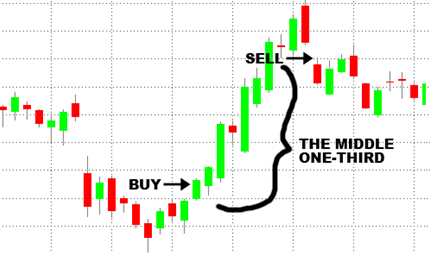By: Bill Poulos of Profits Run
Today, I'm going to share one of the best 'mind shifts' I've ever discovered when it comes to trading the markets.
Now, let’s look at going after profits in the middle one-third of a trend. So take a look at this chart where I’ve zoomed in on a nice uptrend.

Now here’s what most people think you have to do to create wealth trading the markets. They think you have to buy at the very bottom of a trend as seen here, and then sell at the very top. Anything less than that is perceived as a failure.
Well, one of the greatest traders of the 20th Century, Bernard Baruch, who was a multi-millionaire and who also went on to become a presidential advisor, had this to say about trying to capture the entire trend. He said:
"Don’t try to buy at the bottom and sell at the top. It can’t be done, except by liars. I can’t help making money. I just wait for the market to bottom. Then I buy on the way up, and then I sell before the top. I'm satisfied with the middle one-third of the move."
Now this is a very, very profound concept, and I want to emphasize this again. Baruch said, "I just wait for the market to bottom, and buy on the way up. Then I sell before the top. I’m satisfied with the middle one-third of the move."
That’s the secret: the middle one-third. If that doesn’t make sense to you, here’s another way to look at it. Babe Ruth, Hank Aaron, and Barry Bonds are all masters of the middle one-third. They understood that all you need to do to hit the most homeruns, over time, is to hit the ball one out of every three times you step up to the plate.
What do you think would have happened if Babe Ruth had given up early in his career because he didn’t hit the ball 100% of the time? Of course, we wouldn’t be talking about him right now.
Just like Bernard Baruch and just like many of the rich, all three of these homerun kings were satisfied with the middle one-third. So let's look at what Baruch was talking about in a little more detail, so you can implement this concept yourself.

This is the same chart we just saw, but applying Baruch’s philosophy to it. This is what the middle one-third looks like. Now, you might be thinking: "Well, what about the rest of the move? I'd be paying too much if I miss the bottom or I'd be selling too low if I miss the top."
Well, that’s how the middle class thinks. They think you need to capture it all, but some of the wealthiest people on the planet, like Baruch, figured out long ago that the middle one-third of a trend is much easier to take advantage of.
All you need to do is wait for a trend to develop, hop on board, and then sell before it ends. Now, in practice, what we actually end up doing is selling a few days after a trend peaks, and that’s why the sell arrow points to the spot on the other side of the trend.
Do you see how that works? It's easy and it's what the rich do every day to keep and grow their wealth.
This is just one of 4 steps to achieving market mastery that I teach on my new training website for free. To learn the other 3, click here...

 On the Trader's Blog you've heard us talk plenty about how to simplify your trading. As a matter of fact, you've heard Adam preach about keeping it simple over the years. Today we've asked Bill Poulos from Profit's Run to share with us how he keeps his trading method simple by using a simple indicator that we could all benefit from. To find out more about Bill Poulos visit his
On the Trader's Blog you've heard us talk plenty about how to simplify your trading. As a matter of fact, you've heard Adam preach about keeping it simple over the years. Today we've asked Bill Poulos from Profit's Run to share with us how he keeps his trading method simple by using a simple indicator that we could all benefit from. To find out more about Bill Poulos visit his